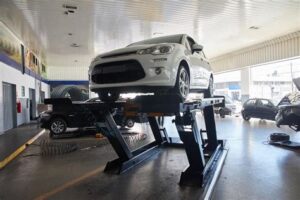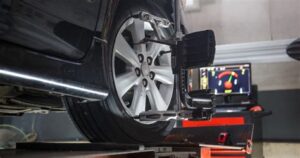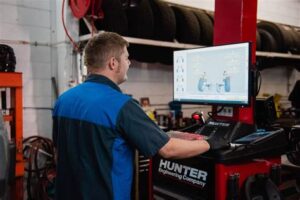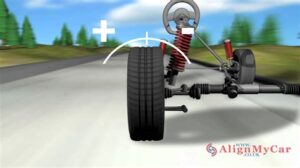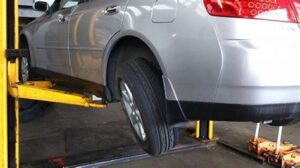Getting behind the wheel of a classic car is a nostalgic experience that evokes fond memories of the golden era of automotive design. However, to truly enjoy that drive, maintaining your classic car’s performance is essential, and one key aspect is front end alignment. Proper alignment not only ensures that your vehicle handles seamlessly but also preserves its vintage charm and integrity. In this article, we will delve into the basics of classic car front end alignment, explore the common symptoms of misalignment, and outline the steps to achieve perfect alignment. Moreover, we’ll highlight the benefits of regular alignment checks and guide you on when to seek professional help. Join us as we navigate the road to keeping your classic car in pristine condition!
Understanding Classic Car Front End Alignment: The Basics
Front end alignment is a critical aspect of maintaining the performance and safety of your classic car. It involves adjusting the angles of the wheels to ensure they are correctly positioned relative to each other and the road. Proper alignment contributes to even tire wear, improved handling, and a smoother ride, making it particularly important for the vintage and collectible models that enthusiasts cherish.
There are three main parameters to consider when performing front end alignment: camber, caster, and toe. Each parameter affects how your classic car interacts with the road and influences its overall performance.
| Parameter | Description |
|---|---|
| Camber | The angle of the wheels in relation to the vertical axis. Positive camber means the top of the wheel tilts outward, while negative camber means it tilts inward. |
| Caster | The angle of the steering axis when viewed from the side. A positive caster angle helps with straight-line stability. |
| Toe | The angle at which the tires point inward or outward when viewed from above. Toe-in means tires point towards each other, while toe-out means they point away. |
Maintaining these angles within the manufacturer’s specifications is vital for ensuring optimal handling characteristics, especially under different driving conditions. A misaligned front end can lead to premature tire wear, difficulty steering, and an uncomfortable driving experience, which is the last thing you want for your beloved classic car.
Regular checks and adjustments not only enhance your vehicle’s performance but also ensure that your classic ride remains a joy to drive for years to come.
Common Symptoms of Misalignment in Classic Cars
Misalignment in a classic car can lead to various issues that not only affect vehicle performance but also safety. Recognizing the symptoms early on can save you from costly repairs down the line. Here are some common indicators of misalignment:
- Uneven Tire Wear: If you notice that the tires are wearing unevenly, it could be a sign that your classic car is misaligned. The wear pattern can indicate whether the tires are tilted inwards or outwards.
- Pulling to One Side: When driving, if your vehicle consistently pulls to the left or right, it’s a clear symptom of alignment issues. The steering wheel may also feel off-center.
- Steering Wheel Vibration: A vibrating steering wheel while driving can be caused by misalignment, impacting your overall driving experience and comfort.
- Loose Steering Wheel: If your steering feels less responsive or more difficult to control than usual, this may be due to improper alignment.
- Squirming Tires: If the tires seem to respond sluggishly to steering input, it could suggest alignment problems affecting handling and stability.
Addressing these symptoms promptly can prevent more severe issues and ensure that your classic car remains enjoyable to drive.
Steps to Achieve Perfect Front End Alignment
Achieving perfect front end alignment in your classic car is essential for optimal performance and safety. Here are the steps you need to follow:
- Gather Necessary Tools: To start, you’ll need basic tools such as a tape measure, an alignment gauge, and jack stands. Having the right equipment is crucial for accuracy.
- Prepare the Vehicle: Ensure your classic car is on a flat, level surface. Check tire pressure and make sure your tires are in good condition, as worn tires can dramatically affect alignment readings.
- Measure the Toe Angle: Use a tape measure to check the distance between the front and rear edges of the tires. Ideally, the front should be slightly narrower than the back, indicating a slight toe-in. Adjust accordingly to achieve the precise angle.
- Adjust Camber and Caster: Next, check the camber angle using an alignment gauge. The top of the tire should lean slightly inward towards the center of the vehicle. For the caster angle, ensure the steering axis tilts toward the rear of the car; this is often factory-set and might require professional adjustment.
- Test Drive the Vehicle: After making adjustments, take your classic car for a test drive. Pay attention to handling and steering response. This will help determine if further adjustments are needed.
- Perform Final Checks: After the test drive, re-check all the angles to ensure nothing has shifted during the drive. Fine-tune as necessary to achieve the perfect alignment.
By following these steps, you can ensure that your classic car maintains optimal performance and a smooth ride on the road.
Benefits of Regular Front End Alignment for Classic Cars
Maintaining a classic car involves numerous aspects, one of which is ensuring proper front end alignment. Regular alignment checks and adjustments can significantly enhance the performance and longevity of your vehicle. Here are some key benefits of regular front end alignment for classic cars:
Incorporating regular front end alignments into your classic car maintenance routine can significantly enhance performance, safety, and overall enjoyment of your vintage ride.
When to Seek Professional Help for Classic Car Alignment Issues
Maintaining your classic car is essential for its performance and safety, particularly when it comes to front end alignment. While some issues can be addressed with basic mechanical skills, others require the expertise of a professional. Here are key indicators that it may be time to seek professional help:
- Persistent Uneven Tire Wear: If you notice uneven wear on your tires despite regular maintenance, this is a strong indication that your classic car may have alignment issues that need professional assessment.
- Pulling to One Side: If your vehicle consistently pulls to one side while driving, it indicates a misalignment that a professional can resolve.
- Steering Wheel Misalignment: If your steering wheel is off-center when driving straight, it is a clear sign of misalignment requiring professional intervention.
- Vibration or Wobbling: Any unusual vibrations or wobbling sensations, especially at higher speeds, can be symptoms of alignment issues, warranting a professional check-up.
- Difficulty in Steering: If you experience tightness or excessive looseness in the steering, it might be a result of alignment problems, signaling the need for a professional evaluation.
- After an Accident: If your classic car has been involved in an accident, even a minor one, it is advisable to get a professional alignment check, as impacts can easily throw the alignment off.
Addressing alignment issues early on can save you considerable costs in repairs and prolong the life of your tires and suspension system. When in doubt, consulting with a professional mechanic who specializes in classic cars can ensure that your vehicle receives the care it needs to perform optimally.
Frequently Asked Questions
What is front end alignment in classic cars?
Front end alignment is the adjustment of the angles of the wheels so that they are set to the car manufacturer’s specifications. This process ensures that the tires wear evenly, and the vehicle handles correctly.
Why is front end alignment important for classic cars?
Front end alignment is crucial for classic cars because it helps maintain proper handling, extends the life of the tires, and enhances overall driving safety. Classic cars often have unique suspension setups, making alignment even more critical.
How can I tell if my classic car needs a front end alignment?
Common signs that your classic car may need a front end alignment include uneven tire wear, the car pulling to one side while driving, steering wheel vibration, or a steering wheel that is off-center when driving straight.
How often should I check the front end alignment on my classic car?
It is generally recommended to check the front end alignment on your classic car every 6,000 miles or once a year. However, if you notice any symptoms of misalignment, you should check it sooner.
What are the steps involved in a front end alignment?
The steps for a front end alignment include inspecting the suspension for wear, adjusting the camber, caster, and toe angles as needed, and then testing the vehicle for proper steering and handling.
Can I perform front end alignment on my classic car myself?
While it is possible to perform a basic alignment yourself with the right tools and knowledge, it is recommended to have it done by a professional, especially for classic cars with complex suspension systems.
What tools are needed for a front end alignment?
Tools required for front end alignment typically include a camber gauge, toe plates, a bubble level, jack stands, and a tape measure. Specialized alignment machines are often used in professional shops.
